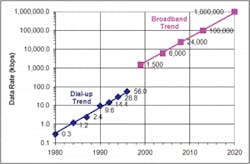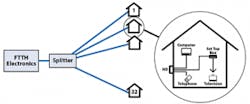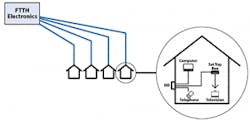The Future of FTTx at Nunn Telephone Company
The high plains grassland of northern Colorado is an area of natural beauty. Cactus blooms yellow and purple in spring, and herds of antelope graze along with cattle. This high plains desert sits at an elevation of over a mile and receives only about 17 inches of rain annually. Cattle ranching and wheat production are the main agricultural enterprises. This is the home of Nunn Telephone Company (the Company). Our 367-square-mile territory includes the communities of Nunn and Carr, and a portion of the Pawnee National Grasslands.
Throughout its history, the Company has provided advanced services to their customers. Our history is not unlike many other small telephone companies in rural areas across the country.
The telephone company dates back to June 20, 1911, when S.E. Hobart was granted a franchise by the Town of Nunn to build a telephone system. His privately- owned magneto, or crank phone telephone system, served the town and rural lines were built by the farmers and ranchers to gain service. A group of local citizens purchased the system in 1948 with a goal of improving voice service, which, at the time, was not available on weekends as the cordboard employees did not work weekends. The lack of weekend support of the cordboard was an unpopular cost savings measure initiated by the private owner.
Around the same time, the Rural Electrification Administration (now known as the Rural Utilities Service) was branching out from rural electrification development to promoting rural telephone deployment. Funding became available to make significant improvements, including iron wire pole line construction. Later, the cordboard was replaced with a mechanical switch and buried copper cabling replaced iron wire. These were major technological improvements at the time.
Fiber Evolution
Currently, we are approaching another major milestone: the transition to a fully fiber network. As part of this transition, we will be decommissioning our copper-based Digital Subscriber Line (DSL) network that was considered state-of-the-art only a few years ago. Currently, 99% of the customer base is connected by a Fiber-to-the-Home (FTTH) network. This FTTH system will serve 100% of the subscribers when the copper DSL network is decommissioned.
When the DSL network was completed in 2007, the 6 Mbps data service it provided met the needs of the subscribers. However, it has been stated many times that "the broadband of today is the narrowband of tomorrow" — and this has proven to be true. Therefore, we knew that the 6 Mbps DSL service would not be sufficient in the long term. In reviewing broadband growth trends and seeing the demand for greater data connection rates, we initiated planning for the next phase of technology deployment. We suspected that this would include some variation of a FTTx network deployment.
To assist in strategically planning for the future network architecture, we requested a professional engineering and consulting company, Vantage Point Solutions, to conduct a board retreat. The focus of this strategic planning was to develop a design and deployment strategy for an outside plant (OSP) network that would last far into the future (next 20 to 30 years). When trying to determine the best network architecture to meet future customer demands, Vantage Point and Nunn Telephone Company studied historical and projected broadband demands and various network architectures.
Figure 1. Broadband Growth
Historical dial-up and broadband speeds commonly available to US residents (the majority of whom live in metropolitan areas) were plotted on a logarithmic scale from 1980 and projected through the year 2020 as shown in Figure 1. The growth of dial-up Internet appears almost linear, as does the growth in broadband speeds. Many service providers offer 300 Mbps broadband tiers today, and extrapolating current speeds to future years, shows that broadband demand could reach 1 Gbps by 2020. In fact, some providers such as Google Fiber are already rolling out 1 Gbps service.
A primary goal of the board retreat was to avoid the repeating cycle of building an OSP network that was leading-edge when it was built, but quickly becomes obsolete and in need of replacement. History has shown that each new generation of technology generally has a shorter usable lifespan. To avoid this cycle with their OSP network, in 2008 the board evaluated wireline and wireless technologies, as shown in Figure 2.
Figure 2. Broadband Technology Comparison
Based on this discussion, the Company’s board set their focus on a new direction of constructing an entirely fiber-based network. Fiber optic cable has been used by service providers for more than 40 years to build high-speed broadband networks, primarily for long haul transport routes. Over the last 10 to 15 years, fiber has also been used to increase broadband speeds in the local customer network because no other technology can deliver as much broadband speed at such an economical cost. With FTTH, the broadband speed provided is not dependent upon cable length, but electronics, and each new generation of FTTP electronics, allows service providers the ability to offer significantly higher broadband speeds over greater distances without having to make significant changes to their OSP architecture. There is no foreseeable end to the amount of bandwidth that can be provided over fiber cables.
There are many reasons why fiber is the solid technology to construct modern network or upgrade existing networks:
• Fiber is immune to electromagnetic interference, provides reliable services, and minimizes operational expenses. Therefore, it delivers excellent voice and broadband services available today and in the foreseeable future.
• Deployment of fiber has significant economic and performance advantages over other technologies in rural areas in the short run, and these advantages will increase in the long run.
• As broadband demands continue to increase, FTTH will have an increased price advantage over other technologies. Over the last several years, increases in copper prices, advances in technology, and growth in broadband demand, have all worked together to make FTTH an economical technology for providing broadband for replacement of existing plant, and providing service to growth areas.
• Not only is a fiber network less expensive to deploy, maintain, and upgrade, it has superior broadband capabilities, such as being able to offer telecommuting, telemedicine services, and telepresence.
All of these factors made it clear to the Company’s board that copper was a dying technology, and the future was fiber.
Figure 3. PON System
A typical PON system is shown in Figure 3. PON implementations use optical splitters to normally serve up to 32 subscribers per PON connection. PON architectures also allow for lower split ratios, with 16-way, 8-way, and 4-way optical splitters being common.
Gigabit-capable Passive Optical Network (GPON) technology is defined by the International Telecommunications Union (ITU) standards and currently allows for 2.4 Gbps downstream and 1.2 Gbps upstream. This bandwidth is dedicated to the customers on PON. With our current vendor electronics the 32-way PON split delivers up to 100 Mbps dedicated access to all the connections. The PON split can occur anywhere in the network, which adds for a diversity of design options.
Figure 4: Active Ethernet System
An Active Ethernet network is shown in Figure 4. These networks use a dedicated fiber between the central office and the customer. Active Ethernet systems are also symmetrical, meaning they provide equal downstream and upstream rates. Today, most Active Ethernet systems can provide up to 1 Gbps to each subscriber, with some providing 10 Gbps per customer.
In their evaluation, the Company determined that a primarily PON-based network architecture was most efficient in meeting their subscriber broadband needs by minimizing project costs and fiber cable sizes in this very rural service area. However, Nunn has supplemented their PON architecture with active fibers in anticipation of some subscribers requiring 1 Gbps services. We anticipate that the electronics platform will need to be replaced several times over the lifetime of the OSP cables in order to continue to meet subscriber broadband needs, and are looking forward to rolling out GPON advancements, such as 10GPON, which is 4 times faster than GPON.
In 2009, we began constructing the FTTH system, which now serves nearly all of our service territory. FTTH is considered by many to be future-proof, which has proven to be correct from an OSP network perspective. Now that the fiber infrastructure is in place, we will have the ability to increase the broadband speed by upgrading the electronics on the fiber cable, which represents a relatively small portion of the overall fiber network investment. Future fiber technology enhancements will allow higher speeds to be delivered to customers over time with minimal incremental investment.
FTTH has worked well for us. Many other rural telephone companies nationwide have rolled out similar networks or are in the process of doing so. Although the fiber builds are generally the preferred method of improving and expanding the network, each company faces different challenges. For some companies the density of subscribers is low, which drives a high cost per subscriber to consider. For other companies, the soil and rock conditions escalate the network costs. All companies have a common concern over the funding, feasibility, and regulatory environment. Hopefully, by the time this article is published the FCC will have adopted rules for the Alternate Connect America Model (A-CAM) that provide predictable funding for the anticipated 10-year term of the rules.
We were fortunate to be able to upgrade to FTTH over a number of years, starting in 2009 and recently completed in 2016. Many other rural companies are now deploying their chosen FTTx architecture to the benefit of subscribers in rural America. As small rural telephone companies serve 41% of the land mass of the US, as the networks evolve rural America in many cases gains World Class service delivery.
Time will tell whether our fiber network will continue to meet customer demands for the next 30 years, but the current continued research and development by electronics vendors indicates that FTTH PON networks will meet the demands of the next generation.








